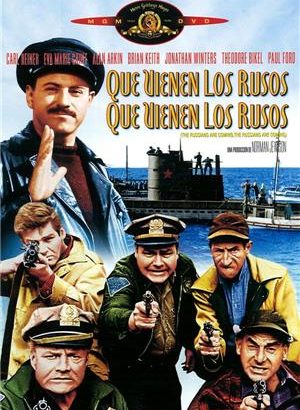
CINE FORO SOBRE CINE AMERICANO – ASPECTOS A CONSIDERAR DURANTE LA VISUALIZACIÓN DE LA PELÍCULA PARA EL POSTERIOR DEBATE: QUE VIENEN LOS RUSOS, QUE VIENEN LOS RUSOS
Un clásico de los años 60, que cosechó un éxito enorme en todo el mundo, incluyendo su propio país. Obtuvo tres nominaciones al Oscar; mejor película, mejor guión y mejor actor (Alan Arkin).
El director, Norman Jewison, es un canadiense nacido en 1926 que se formó trabajando en la TV inglesa. Después, destacó en la americana, y comenzó a dirigir a inicios de los años 60, mediante comedias; así, sobresalió con dos protagonizadas por Doris Day, “Su pequeña aventura” (The Thrill of It All, 1963) y “No me mandes flores” (Send Me no Flowers, 1964). Después, triunfó con “El rey del juego” (The Cincinnati Kid, 1965), que enfrentaba al joven Steve McQueen con el anciano Edward G. Robinson. Acto seguido, hace “Que vienen los rusos” (The Russians Are Coming, 1966), que supone su primera película como productor-director, según la novela de Nathaniel Benchley. Después, ya siempre como productor-director, hizo películas tan exitosas como “En el calor de la noche” (In the Heat of the Night, 1967), que ganó 5 Oscars y conoció secuelas dirigidas por otros realizadores, “El caso Thomas Crown” (The Thomas Crown Affair, 1968), de nuevo con Steve McQueen, los musicales “El violinista en el tejado” (Fiddler on the Roof, 1971), “Jesucristo Superstar” (Jesus Christ Superstar, 1973) y Rollerball (Rollerball, 1975). Actualmente está retirado, su última película ha sido “La sentencia” (The Statement, 2003), con Michael Caine y Tilda Swinton.
“Que vienen los rusos, que vienen los rusos” es una película de orientación familiar, que ironiza sobre la “guerra fría” que desde el fin de la Segunda Guerra Mundial enfrentaba solapadamente a los Estados Unidos con la Unión de Repúblicas Socialistas Soviéticas, la actual Rusia. El enfoque fue muy atrevido, porque satiriza abiertamente la paranoia patriótica americana, tanto mediante la historia, de suaves matices alegóricos, cuanto por el conjunto de personajes, todos en el límite de la caricatura, pero sin llegar a serlo.
Los personajes son a cuál más acertado, brillantes en sí mismos y dentro del conjunto. Están perfilados en el tono justo, e interpretados de forma que resulten representativos y graciosos por igual. El mérito de esto también corresponde a los intérpretes, todos muy bien escogidos y dirigidos. Con todo, cuatro sobresalen, tanto que resultan inolvidables: Eva Maria Saint, como la típica esposa americana de la época, John Phillip Law, tan guapo como angelical e ingenuo, Brian Keith, como sheriff rural honesto a su manera, y sobre todo Alan Arkin, como el militar soviético que pretende ser eficaz y razonable al mismo tiempo. Arkin debutó con esta película, procedía del teatro. Law tampoco era conocido del público americano, pues antes había trabajado básicamente en Italia. Y Saint en cambio había trabajado con directores tan importantes como Elia Kazan, en “La ley del silencio” (On the Waterfront, 1954) y Alfred Hitchcock, en “Con la muerte en los talones” (“North by NorthWest, 1958).
El ritmo es suave y gentil, y el tono compagina la sátira, la emoción, la diversión y la sensibilidad, en una mixtura de estados de ánimo muy difícil de conseguir en Cine. La técnica es invisible, con una cámara que se mueve del modo justo, sin alardes y siempre al servicio del tono, con un empleo magnífico del formato en pantalla ancha, y unos colores suaves que confieren al conjunto un encanto pictórico tan sutil y contendido como los demás ingredientes de la película, que es una auténtica filigrana.



